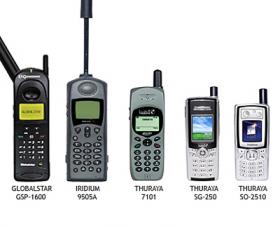Globalstar - degradation of the amplifiers
 One thing you really want to have as a satellite communications company is a nice collection of well-functioning satellites. Without them, to state the incredibly obvious, you own a nice collection of space junk. And that is the problem that now faces GlobalStar, the satellite communications provider.
One thing you really want to have as a satellite communications company is a nice collection of well-functioning satellites. Without them, to state the incredibly obvious, you own a nice collection of space junk. And that is the problem that now faces GlobalStar, the satellite communications provider.On Feb 7th, 2007 the company filed an incredible 8-K document with the SEC. In a section labeled “Satellite Constellation Operations,” the company made some disturbing disclosures. Globalstar has previously said that a number of its satellites have suffered from degradation of performance of power amplifiers to the S-band antenna which provides the downlink to subscriber phones or data terminals.
 The result can be reduced quality and call duration. If the S-band antenna stops working, then you can’t have a two-way conversation using the specific satellite. GlobalStar conjectures that the amplifier problem might relate to irradiation in orbit, but it isn’t entirely sure. The company says it has managed the issue in various ways, including placing spare satellites already in orbit into service and moving its satellites to different orbits. Previously, the company has said that with the addition of eight spare satellites planned for launch in 2007, two-say service would be viable until a set of next-generation satellites were placed into service in 2009.
The result can be reduced quality and call duration. If the S-band antenna stops working, then you can’t have a two-way conversation using the specific satellite. GlobalStar conjectures that the amplifier problem might relate to irradiation in orbit, but it isn’t entirely sure. The company says it has managed the issue in various ways, including placing spare satellites already in orbit into service and moving its satellites to different orbits. Previously, the company has said that with the addition of eight spare satellites planned for launch in 2007, two-say service would be viable until a set of next-generation satellites were placed into service in 2009.And now, the punch line: Based on data recently collected from satellite operations, the Company has concluded that the degradation of the amplifiers is now occurring at a rate that is faster than previously experienced and faster than the Company had previously anticipated. In response, the Company, in consultation with outside experts, has implemented innovative methods, and plans to continue to implement additional corrective measures, to attempt to ameliorate this problem, including modifying the configuration of its constellation as described above, and thereby extend the life of the two-way communication capacity of the constellation. Nonetheless, to date the Company has been unable to correct the amplifier problem and may be unable to do so.
 GlobalStar says it is “exploring the feasibility of accelerating procurement and launch of its second-generation satellite constellation, to attempt to reduce the effects of this problem upon its customers and operations.” It says the company “will be able to forecast the duration of service coverage at any particular location in its service area and intends to make this information available without charge to its service providers, including its wholly owned operating subsidiaries, so that they may work with their subscribers to reduce the impact of the degradation in service quality in their respective service areas.”
GlobalStar says it is “exploring the feasibility of accelerating procurement and launch of its second-generation satellite constellation, to attempt to reduce the effects of this problem upon its customers and operations.” It says the company “will be able to forecast the duration of service coverage at any particular location in its service area and intends to make this information available without charge to its service providers, including its wholly owned operating subsidiaries, so that they may work with their subscribers to reduce the impact of the degradation in service quality in their respective service areas.”
